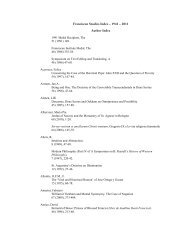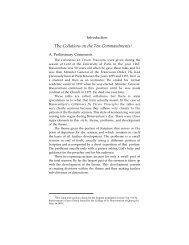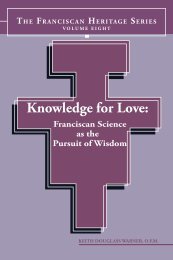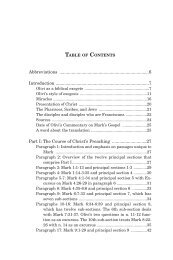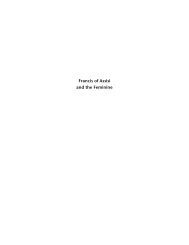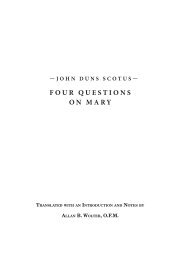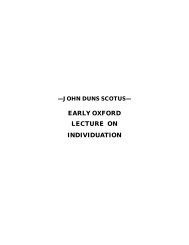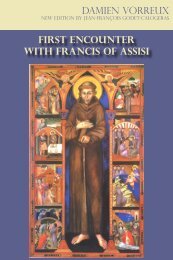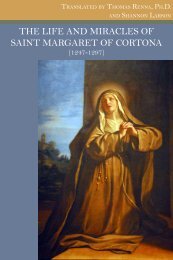Works of St. Bonaventure Works of St. Bonaventure - Franciscan ...
Works of St. Bonaventure Works of St. Bonaventure - Franciscan ...
Works of St. Bonaventure Works of St. Bonaventure - Franciscan ...
Create successful ePaper yourself
Turn your PDF publications into a flip-book with our unique Google optimized e-Paper software.
XVIIIST. BONAVENTURE’S BREVILOQUIUM<strong>of</strong> the community so they would be well-equipped for theirprimary ministry <strong>of</strong> preaching and hearing confessions.Theology classes were an integral part <strong>of</strong> their weekly schedule.This created a constant demand for qualified friars toserve as lectors. To meet it, promising young friars wereassigned to pursue theological studies at schools the Orderhad established, not only at the universities <strong>of</strong> Paris, Oxford,and Cambridge, but also in more than a dozen otherstudia generalia (general study centers) that had sprungup by this time. 15 The curriculum in these other study centerslargely replicated that <strong>of</strong> the university faculties <strong>of</strong>theology. To be qualified as a lector, a friar had to studytheology for four years. For the first two he attended lectureson the Bible, then two more on the Four Books <strong>of</strong> Sentences<strong>of</strong> Peter Lombard. 16 This was a top-notch educationfor the time, a fact recognized by a Papal privilege<strong>Bonaventure</strong> obtained shortly after his election that grantedstudents who had completed the curriculum at the Order’sstudia generalia a license to teach theology, thus grantingthem an equivalent <strong>of</strong> a university degree. 17However, by today’s standards, young friars in the1250’s were singularly unequipped to embark on theologi-15Roest, 6-42. In addition to the three <strong>Franciscan</strong> schools that wereincorporated into University theology faculties, by the 1250’s studyhouses had been established in Bologna, Padua, Florence, Perugia,Naples, Toulouse, Montpellier, Dijon, Magdeburg, Cologne, Regensburg,<strong>St</strong>rasbourg, and Erfurt. These schools were ‘general’ in the sense thatthey attracted friar students from beyond their own provinces, eventhough some were effectively only regional. We are not certain preciselywhen each <strong>of</strong> these studia was <strong>of</strong>ficially designated ‘general.’ It isimportant to note that these study centers also were open to secularclergy. For the legislation governing the studia, see the Constitutions<strong>of</strong> Narbonne, 6.12-24 in <strong>Works</strong> <strong>of</strong> <strong>St</strong>. <strong>Bonaventure</strong> 5: 101-103 (note 127on p. 102 must be corrected in light <strong>of</strong> Roest’s study).16Roest, 87-97, 133-137.17Exultante spiritu (23 March 1257), Bullarium <strong>Franciscan</strong>um, 2:208b,n. 317. Cf. Roest, 31.



